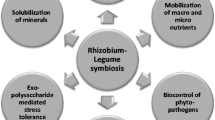Abstract
Rhizobia are confronted by a wide variety of organic substances in soils, including aromatic substances released by plants and those of man-made origin. They have developed mechanisms to degrade and mineralize aromatic substances through the activity of oxygenases encoded by the genes present in the chromosome and in plasmid(s). Genes involved in the synthesis of some of the oxygenases have been identified and characterized. Glucose and succinate caused repression of phenol utilization. Some of the enzymes involved in aromatic metabolism including the enzymes associated with the uptake of aromatic substances by the cells have been identified and characterized. Aromatic substances, in addition to inducing catabolic genes, also induced the genes required to form active associations with the host plants (legumes).
Similar content being viewed by others
References
Agarwal, P. & Mahadevan, A. 1983 Lectins in plant disease. In Recent advances in plant pathology, eds Hussain, A., Singh, B.P., Singh, H.K. & Singh, V.P. p. 385. Lucknow, India: Print House.
Chen, Y.P., Dilworth, M.J. & Glenn, A.R. 1984a Uptake and oxidation of aromatic substances by Rhizobium leguminosarum MNF 8841 and Rhizobium trifolii TA1. FEMS Microbiology Letters 21, 201–205.
Chen, Y.P., Dilworth, M.J. & Glenn, A.R. 1984b Aromatic metabolism of Rhizobium trifolii-protocatechuate 3,4-dioxygenase. Archives of Microbiology 138, 187–190.
Chen, Y.P. & Lovell, C.R. 1990 Purification and properties of catechol 1,2-dioxygenase from Rhizobium leguminosarum bv. viceae USDA 2370. Applied and Environmental Microbiology 56, 1971–1973.
Chen, Y.P., Glenn, A.R. & Dilworth, M.J. 1985 Aromatic metabolism inRhizobium trifolii-catechol 1,2-dioxygenase. Archives of Microbiology 141, 225–228.
Dilworth, M.J. & Glenn, A.R. 1981 Control of carbon utilization by rhizobia. In Current perspectives in nitrogen fixation, eds Gibson, A.H. and Newton, W.E. pp. 244–251. Canberra, Australia: Australia Academy of Science.
Dilworth, M.J., Mckay, I., Franklin, M. & Glenn, A.R. 1983 Catabolite effects on enzyme induction and substrate utilization in Rhizobium leguminosarum. Journal of General Microbiology 129, 359–366.
Evans, W.C. & Fuchs, G. 1988 Anaerobic degradation of aromatic compounds. Annual Review of Microbiology 42, 289–317.
Gajendiran, N. & Mahadevan, A. 1988 Utilization of catechin by Rhizobium sp. Plant and Soil 108, 263–266.
Gajendiran, N. & Mahadevan, A. 1990a Growth of Rhizobium sp. in the presence of catechol. Plant and Soil 125, 207–211.
Gajendiran, N. & Mahadevan, A. 1990b Influence of phenols and sugars on catechol 1,2-dioxygenase in Rhizobium sp. Indian Journal of Experimental Biology 28, 265–267.
Gajendiran, N. & Mahadevan, A. 1990c Utilization of phenolic substances by Rhizobium sp. Indian Journal of Experimental Biology 28, 1136–1140.
Gajendiran, N. & Mahadevan, A. 1990d Plasmid borne catechol dissimilation in Rhizobium sp. FEMS Microbiology Ecology 73, 125–130.
Gajendiran, N. & Mahadevan, A. 1991 Catechol degradation by immobilized Rhizobium sp. Zentralblatt für Mikrobiologie 146, 99–101.
Hamdi, Y.A. & Tewfik, M.S. 1970 Degradation of 3,5-dinitroo-cresol by Rhizobium and Azotobacter spp. Soil Biology and Biochemistry 2, 163–166.
Harborne, J.B. 1980 Plant phenolics. In Secondary plant products, eds Bell, E.A. & Charlwood, B.V. Encyclopedia of Plant Physiology NS, 8, 329–402. Berlin: Springer-Verlag.
Hussien, Y.A., Tewfik, M.S. & Hamdi, Y.A. 1974 Degradation of certain aromatic compounds by rhizobia. Soil Biology and Biochemistry 6, 377–381.
Lewis, J.A. & Starkey, R.L. 1969 Decomposition of plant tannins by soil microorganisms. Soil Science 107, 235–241.
Muthukumar, G., Arunakumari, A. & Mahadevan, A. 1982 Degradation of aromatic compounds by Rhizobium spp. Plant and Soil 69, 163–169.
Pankhurst, C.E., Broughton, W.J. & Wieneke, V. 1983 Transfer of an indigenous plasmid of Rhizobium loti to other rhizobia and Agrobacterium tumefaciens. Journal of General Microbiology 129, 2535–2543.
Parke, D. & Ornston, L.N. 1984 Nutritional diversity of rhizobiaceae revealed by auxanography. Journal of General Microbiology 130, 1743–1750.
Parke, D. & Ornston, L.N. 1986 Enzymes of the β-Ketoadipate pathway are inducible in Rhizobium and Agrobacterium species and constitutive in Bradyrhizobium species Journal of Bacteriology 165, 288–292.
Parke, D., Rivelli, M & Ornston, L.N. 1985 Chemotaxis of aromatic and hydroaromatic acids: Comparison of Bradyrhizobium japonicum and Rhizobium trifolii. Journal of Bacteriology 163, 417–422.
Peters, N.K. & Verma, D.P.S. 1990 Phenolic compounds as regulators of gene expression in plant-microbe interactions. Molecular Plant-Microbe Ineteractactions 3, 4–8.
Podila, G.K., Kotagiri, S. & Santharam, S. 1993 Cloning of protocatechuate 3,4-dioxygenase genes from Bradyrhizobium japonicum USDA 110. Applied and Environmental Microbiology 59, 2717–2719.
Vance, C.P. 1978 Comparative aspects of root and root nodule secondary metabolism in alfalfa. Phytochemistry 17, 1889–1891.
Vasudevan, N. & Mahadevan, A. 1990 Utilization of catechin by microorganisms. Current Science 59, 1323–1325.
Waheeta, A. & Mahadevan, A. 1987 Utilization of catechin and its metabolites by Bradyrhizobium japonicum. National symposium on new frontiers in microbial technology. 15–17 February. Department of Microbiology, Bhopal University, Bhopal, India.
Waheeta, H. & Mahadevan, A. 1991 Utilization of catechin and its metabolites by Bradyrhizobium japonicum. Applied Microbiology and Biotechnology 35, 411–415.
Waheeta, A. & Mahadevan, A. 1994 Degradation of aromatic substances by rhizobia. Frontiers of Applied Microbiology 7, 3756.
Werner, D., Dittrich, W. & Thierfelder, H. 1982 Malonate and Kreb′s cycle intermediates utilization in the presence of other carbon sources by Rhizobium leguminosarum and soybean bacteriods. Zeitschrift für Naturforschung 37c, 921–926.
William, F., Boominathan, K., Vasudevan, N., Gurujeyalakshmi, G. & Mahadevan, A. 1986 Microbial degradation of lignin and tannin. Journal of Scientific and Industrial Research 45, 232–243.
Wong, C.M. Dilworth, M.J. & Glenn, A.R. 1991 Evidence for two uptake systems in Rhizobium leguminosarum for hydroxy aromatic compounds metabolized by the 3-oxoadipate pathway. Archives of Microbiology 156, 385-391.
Wong, C.M., Dilworth, M.J. & Glenn, A.R. 1994 Cloning and sequencing show that 4-hydroxybenzoate hydroxylase (pob A) is required for uptake of 4-hydroxbenzoate in Rhizobium leguminosarum. Microbiology. 140, 2775-2786.
Author information
Authors and Affiliations
Rights and permissions
About this article
Cite this article
Latha, S., Mahadevan, A. Role of rhizobia in the degradation of aromatic substances. World Journal of Microbiology and Biotechnology 13, 601–607 (1997). https://doi.org/10.1023/A:1018598200187
Issue Date:
DOI: https://doi.org/10.1023/A:1018598200187




